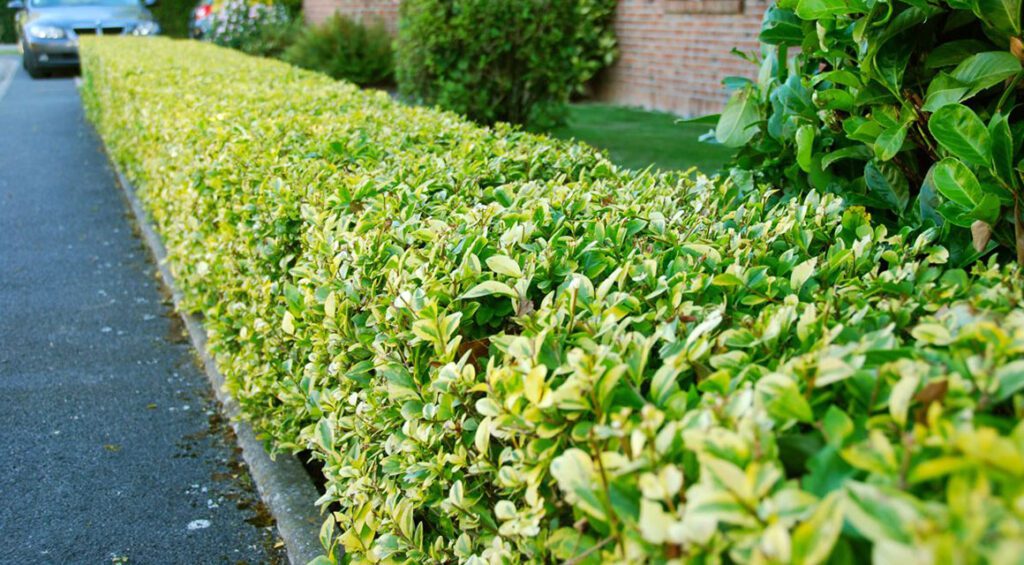There is actually nothing more beautiful than to delimit your garden with a hedge. If you have small children, then you should already think about which hedge plants you want to use then best in the garden. After all, some hedge plants can become a risk for small children, and it is precisely this risk that you want to avoid in a child-friendly garden, of course. Unfortunately, most evergreen hedge plants are poisonous. You also don’t want your children to get hurt by your hedge. To help you with your selection, we are now happy to show you which hedge suits a child-friendly garden.

Contents
Avoid hedge plants with thorns
Thorny hedge plants are also popularly used as burglar-resistant hedges. And this is understandable, because intruders do not like to try to get through the thorns of a firethorn hedge or barberry hedge, encroaching hawthorn can also be mentioned here. This is true for people and for animals. This impenetrability is gladly used by birds, which then build their nests between the thorny branches. However, for small children, a thorny hedge can be dangerous. The danger is greatest with strong thorns, as is also the case with an encroaching hawthorn or a blackthorn. Cutting back these hedges can only be done with suitable gardening gloves to avoid an accident.
There is no more effective solution than a thorn hedge, if it should be burglar-proof. As an alternative, you can still think about a hedge that is well branched. Branching can be encouraged by regular pruning. After all, if you cut a branch, then the hedge will branch exactly at the intersection. In the case of varieties that are naturally compact and strongly branched, as in the case of the beech hedge, field maple or hornbeam, this will later lead to the fact that they can still be used as a privacy hedge in the winter. These child-friendly, burglar-resistant hedges will then have no thorns, but they will still be impenetrable.

Watch out for poisonous hedge plants
Some children have a tendency to put everything in their mouths. Normally, this is not a problem, but when it comes to poisonous plant parts, it can have dire consequences. Therefore, poisonous hedge plants should be avoided if you have small children. The wonderful yew will immediately fall through. Yew berries look tempting, but the seeds of the fruit contain the life-threatening poison taxine, although the red pulp of the berries is edible. Livestock die after eating the berries, and this poison is also a great risk to us humans. By the way, all other plant parts of yew are also highly poisonous.
With other conifers, such as the Leyland cypress, the tree of life or the mock cypress, the risk is less, although these conifers are much more sensitive when it comes to proper care. In addition, contact with the leaves can cause irritation to the skin. Most other evergreen hedge plants are also poisonous, although then there are varieties with berries that do not cause immediate death. For example, if your child swallows five to ten berries of the popular cherry laurel hedge, then the side effects can be neutralized with enough water. You should then also always contact your doctor, better safe than sorry.
This then applies, for example, to the wonderful holly, but also to the Japanese holly, which nowadays is increasingly used as a substitute for boxwood in the garden. By the way, the boxwood is quite poisonous by nature and this then also applies to all plant parts of the boxwood. This is also the case with a privet, although privet hedges often can no longer form berries because they are already cut back beforehand. The result is then a formal hedge, but also a hedge that will no longer quickly become a danger to your children.

Children get a lot of pleasure from a colorful garden
Your children will always enjoy a colorful garden that has many flowering hedge plants. This will make the children want to play in the garden. But also the birds and butterflies that are attracted by the nectar and berries of these hedge plants will immediately make the garden much more child-friendly. But it’s also wonderful for you as a garden owner. It’s also nice to know that most, flowering hedge plants from our web store are non-toxic, although the fruits of the copper rock pear can cause digestive problems. The potato rose and the dog rose even form edible rose hips, which contain a lot of vitamin C.
These two varieties of roses then produce wonderful flowers first, which later turn into berries. You will also get many blossoms if you plant a butterfly bush in the garden. The flowers have wonderful colors just like the butterflies and bees that are attracted to a butterfly bush. But what do you think of a yellow dogwood that blooms early? What do you think of the finger shrub, shrub spirea, ornamental deutzia or weigelie? If you want to intensify the colors, combine different varieties in a mixed flowering hedge. It’s nice for you and for your child! And you can still learn about hedge plants with edible berries here.
With a child-friendly garden, you won’t have to constantly watch your child, and you too will then enjoy the beauty and function of your hedge that suits you. Have you already made a decision? You can always take a closer look at our online hedge plant assortment if you need more inspiration. Via contact you can also reach our customer service if you need our advice.

